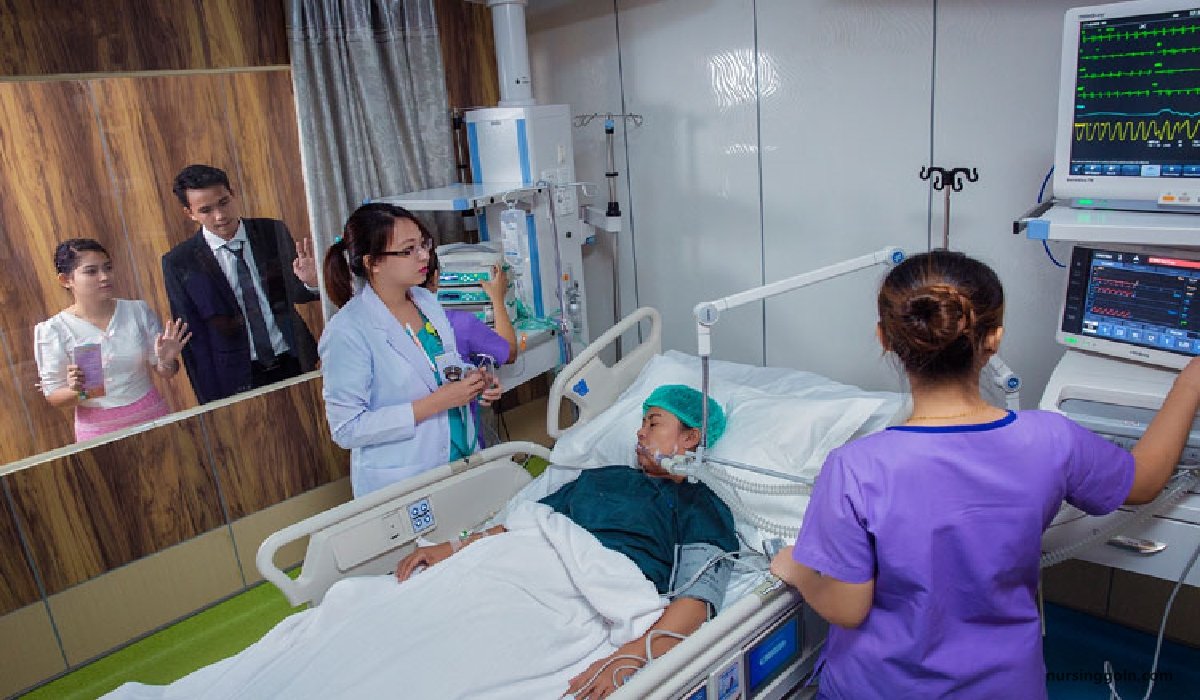ICU/HDU care – This course is designed to understand the concept of community health nursing: nurses’ roles and interventions in family health, school health, occupational health, environmental health, elderly health care, gender issues, disaster management and principles and terminology of epidemiology. The aim of the course is to acquire knowledge and skills in community health nursing.

ICU/HDU care
| 1. Neonatal intensive care unit (NICU) | This specialty unit cares for neonatal patients who have not left the hospital after birth |
| 2. Pediatric intensive care unit (PICU) | Pediatric patients are treated in this intensive care unit for life- threatening medical problems such as asthma, influenza, diabetic ketoacidosis, or traumatic brain injury. |
| 3. Psychiatric intensive care unit (PICU). | Patients who may voluntarily harm themselves are delivered here so they can be monitored more vigorously. Patient rooms are locked, preventing escaping. |
| 4. Coronary care unit (CCU): | Also known as Cardiac Intensive Care Unit (CICU) or Cardiovascular Intensive Care Unit (CVICU), this ICU caters to patients specifically with congenital heart defects or life-threatening acute conditions such as cardiac arrest. |
| 5. Neurological intensive care unit (Neuro ICU) | Patients here are treated for aneurysms, brain tumors, stroke, rattlesnake bites and post-surgical patients who have undergone various neurological surgeries and require hourly neurological exams |
| 6. Trauma intensive care unit | (Trauma ICU). These are found only in hospitals certified in Trauma and have a dedicated Trauma Emergency Department equipped with a team of surgeons, nurses, respiratory therapists, and radiological staff. |
| 7. Post-anesthesia care unit (PACU) | Also known as the post-operative recovery unit, or recovery room, the PACU provides immediate post-op observation and stabilization of patients following surgical operations and anesthesia. |
| 8. High dependency unit (HDU) | These units are also called step-down, progressive and intensive recovery units and are utilised until a patient’s condition stabilizes enough to qualify them for discharge to a general ward |
| 9. Surgical Intensive Care Unit (SICU): | A specialized service in larger hospitals that provides inpatient care for critically ill patients on surgical services. As opposed to other ICUs, the care is managed by surgeons trained in critical-care. |
Roles of Critical Care Nurse:
| A. Knowledge and Skills: |
|
| B. Technology and Equipment |
|
| C. Coordinating Care |
|
| D. End of Life Care |
|
IN SHORT
- Respect and support the right of the patient or the patient’s designated surrogate to autonomous informed decision making.
- Intervene when the best interest of the patient is in question.
- Help the patient obtain necessary care.
- Respect the values, beliefs and rights of the patient.
- Provide education and support to help the patient or the patient’s designated surrogate make decisions.
- Represent the patient in accordance with the patient’s choices.
- Support the decisions of the patient or designated surrogate, or transfer care to an equally qualified critical care nurse.
- Intercede for patients who cannot speak for themselves in situations that require immediate action.
- Monitor and safeguard the quality of care the patient receives
- Act as a liaison between the patient, the patient’s family and other healthcare professionals.
- Maintain balance diet and drugs chart.
- Maintain intake and output chart.
- Monitor strictly patient conditions.
- Maintain good personal hygiene and strict aseptic techniques when performing any procedures.
Where Critical Care Nurses Work
- Intensive Care Units,
- Pediatric ICUs,
- Neonatal ICUs,
- Cardiac Care Units,
- Cardiac Catheter Labs,
- Telemetry Units,
- Progressive Care Units,
- Emergency Departments and Recovery Rooms.

Conditions for admitting in critical care unit are given bellow:
| 1. Sepsis: |
|
| 2. Traumatic Brain Injury: |
|
| 3. Shock: |
|
| 4. Ruptured Brain Aneurysm or stroke: |
|
| 5. Trauma: |
|
| 6. Post-operative Intensive Care | Some patients may require monitoring in the ICU after surgery. Causes ✔ There are several problems which may occur during surgery which may lead a patient to the ICU. ✔ Common examples include –
|
| 7. Cancer-related Intensive Care |
|
| 8. Heart Failure: |
|
| 9. Respiratory (Lung) Failure: |
|
Responsibilities of a ICU/HDU Nurse:
- Consults and coordinates with health care team members to assess, plan, implement and evaluate patient care plans
- Prepares and administers (orally, subcutaneously, through an IV) and records prescribed medications.
- Reports adverse reactions to medications or treatments in accordance with the policy regarding the administration of medications by a licensed registered nurse
- Provides basic, bedside care.
- Initiates patient education plan, as prescribed by physician.
- Teaches patients and significant others how to manage their illness/injury, by explaining: post- treatment home care needs, diet/nutrition/exercise programs, self-administration of medication and rehabilitation
- Records patients’ medical information and vital signs
- Orders, interprets and evaluates diagnostic tests to identify and assess patient’s condition
- Takes samples for lab work, orders prescribed lab work and evaluates/interprets lab reports
- Prepares equipment and aids physician during examination and treatment of patient
- Responds to life-saving situations based upon nursing standards and protocol
- Records all care information concisely, accurately and completely, in a timely manner, in the appropriate format and on the appropriate forms.
- Applies Hemodynamic, Phlebotomy and IV protocols.
- Monitors and adjusts specialized equipment used on patients, and interprets and records electronic displays, such as intracranial pressures, central venous pressures, pulmonary artery pressures, and cardiac rhythms from cardiac monitors, respirators, ventilators, manometers, oxygen pumps, etc.
- Monitors catheters, leads and tubing for proper placement and functioning
- Initiates corrective action whenever information from monitoring/life support equipment shows adverse symptomatology

Risk/Predisposing Factors of Critical Illness:
| 1. Background factors |
|
| 2. Behavioral factors |
|
| 3. Intermediate factors |
|
| 4. Social and economic conditions |
|
| 5. Environment |
|
| 6. Culture |
|
| 7. Urbanization |
|
Read more:
